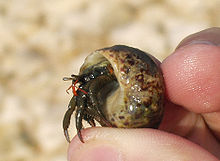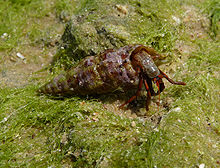- Clibanarius erythropus
-
Clibanarius erythropus 
Scientific classification Kingdom: Animalia Phylum: Arthropoda Subphylum: Crustacea Class: Malacostraca Order: Decapoda Infraorder: Anomura Family: Diogenidae Genus: Clibanarius Species: C. erythropus Binomial name Clibanarius erythropus
(Latreille, 1818) [1]Synonyms [1] - Clibanarius misanthropus (Risso, 1827)
- Pagurus erythropus Latreille, 1818
- Pagurus hirsutus Costa, 1829–1838
- Pagurus misanthropus Risso, 1827
- Pagurus nigritarsis Lucas, 1846
Clibanarius erythropus is a species of hermit crab that lives in rockpools and sublittoral waters.[2] It is found in the Mediterranean Sea, Black Sea and eastern Atlantic Ocean from the Azores to Brittany,[3] and as far north as the Channel Islands.[2] Individuals may grow up to a carapace length of 15 millimetres (0.6 in).[2]
 Clibanarius erythropus, the Black Sea
Clibanarius erythropus, the Black Sea
Ecology
A variety of different gastropod shells are used by C. erythropus, the most frequent being Littorina striata, Mitra, Nassarius incrassatus and Stramonita haemastoma, which collectively account for 85% of all individuals studies in the Azores;[4] in the Mediterranean, shells of Cerithium, Alvania montagui and Pisania maculosa are most used by C. erythropus.[5]
Like other hermit crabs, C. erythropus feeds on "organic debris, decayed and fresh macro-algae with associated fauna and epiphytic algal flora, small invertebrates, and macroscopic pieces of dead and live animal tissues".[3] It has been shown that C. erythropus individuals select substrates where they can cover large distances, and that globose shells allow them greater mobility than elongate ones.[3]
References
- ^ a b Michael Türkay (2009). "Clibanarius erythropus (Latreille, 1818)". In Patsy McLaughlin. World Paguroidea database. World Register of Marine Species. http://www.marinespecies.org/aphia.php?p=taxdetails&id=107196. Retrieved June 8, 2010.
- ^ a b c E. Wilson (2005). "A hermit crab — Clibanarius erythropus". Marine Life Information Network. http://www.marlin.ac.uk/species/Clibanariuserythropus.htm.
- ^ a b c Chiara Benvenuto, Gianfranco Sartoni and Francesca Gherardi (2003). "Foraging behaviour of the hermit crab Clibanarius erythropus in a Mediterranean shore". Journal of the Marine Biological Association of the United Kingdom 83 (3): 457–461. doi:10.1017/S0025315403007331h. http://journals.cambridge.org/action/displayAbstract?fromPage=online&aid=147113.
- ^ Andrea Z. Botelho & Ana C. Costa (2000). "Shell occupancy of the intertidal hermit crab Clibanarius erythropus (Decapoda, Diogenidae) on São Miguel (Azores)". Hydrobiologia 440 (1/3): 111–117. doi:10.1023/A:1004190220509. http://www.ingentaconnect.com/content/klu/hydr/2000/00000440/F0030001/00281595.
- ^ Chiara Benvenuto & Francesca Gherardi (2001). "Population structure and shell use in the hermit crab, Clibanarius erythropus: a comparison between Mediterranean and Atlantic shores". Journal of the Marine Biological Association of the United Kingdom 81 (1): 77–84. doi:10.1017/S0025315401003423. http://journals.cambridge.org/action/displayAbstract?fromPage=online&aid=68147.
Categories:- Hermit crabs
- Crustaceans of the Atlantic Ocean
- Animals described in 1818
Wikimedia Foundation. 2010.
